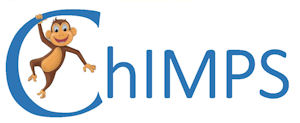Let us reach out to the children. Let us do whatever we can to support their fight to rise above their pain and suffering.Nelson Mandela 1997
Welcome to the ChIMPS

We are here to help children (and their carers) who have pain following surgery and who have painful conditions who come into hospital. We aim to make the pain better using several different methods.
What we do
We are a team of doctors and nurses who specialise in the management of pain relief for children who are cared for on the wards in the hospital.
We provide education, training and expert support to the staff on the wards in all aspects for pain control for children.
We regularly visit the wards to see children who have had surgery and with painful conditions. We give advice on how best to treat pain.
One of the most important aspects of pain control is the assessment of pain. We have developed special tools to help staff, carers and children assess pain: here
Pain relief
We use the best available evidence on the most effective ways to treat pain in children. This includes medicines that can be swallowed, strong pain killers such as morphine and the use of local anaesthetics.
When a child has an operation, they will be seen by an anaesthetist who will discuss how best to provide pain relief after the surgery.
Further information can be found below on the methods that are used to treat pain in children.
Pain assessment
The assessment of pain is an important part of the care your child will receive while in hospital. Children and their families are sometimes worried that they may be in pain when in hospital.
After day case surgery
Your child is allowed to go home on the same day as his/her operation because the operation is relatively small and is not expected to cause too much pain. The anaesthetist will give some pain medicine to your child while they are asleep. This should work to relieve pain for several hours, and usually means that your child will be comfortable on waking. If your child does experience some pain after their operation the following information will help you to decide what to do next.
Morphine
Morphine is used to reduce pain which cannot be controlled by paracetamol or ibuprofen alone. This might be pain following an injury or after an operation. Morphine can be given to children as a liquid which they can swallow, rather than a tablet.
Patient Controlled Analgesia
Patient Controlled Analgesia is a way of giving strong pain relieving medicines (such as morphine) to your child, after a painful operation or during a painful illness whilst in hospital. As the name suggests, the patient (child) is in control of the pain medicine, so that they won't have to wait to ask a nurse for it.
Nurse Controlled Analgesia
Nurse controlled analgesia is a way of giving strong pain relieving medicines (such as morphine) to your child, after a painful operation or during a painful illness whilst in hospital. As the name suggests, the child's nurse will control how much pain medication is given to your child, to help manage their pain.
Epidural Analgesia
An epidural is a way of providing numbing pain relief after an operation. A small plastic tube (epidural catheter) is placed into the epidural space, which surrounds the spinal cord in your child's back.
Caudal Blocks
A caudal block is a pain relieving injection of local anaesthetic which is put in at the bottom of the back (spine). This will make the lower half of your child's body feel numb.
Local Anaesthetic Nerve Blocks
A nerve block is an injection of numbing local anaesthetic given around a nerve. It is used to reduce pain following surgery or after an injury, such as a broken bone.
Other pain management services
We only provide a service for children who are admitted on the inpatient wards: for those who are not admitted, there are other local medical teams that can help, depending on the age of the child or young person with pain.
- Oxford Paediatric and Adolescent Rheumatology Centre (OxPARC)
- Helen and Douglas House
- Pain Management Centre
Contact us
If you have any questions about pain management for a child coming into hospital, please contact us.
Email: ChIMPS@ouh.nhs.uk - we aim to reply within three working days.
Links
- Children's patient leaflets - Oxford University Hospitals
- Oxford Paediatric and Adolescent Rheumatology Centre (OxPARC)
- Pain Management Centre
- Children's Services
- Paediatric Rheumatology
- Children's Haematology and Oncology
- Children's Surgical Services
- Paediatric General and Urological Surgery
- Paediatric Neurosurgery
- Oxford Craniofacial Unit
- Trauma Service: John Radcliffe Hospital
- Paediatric Orthopaedics
- Plastic Surgery

